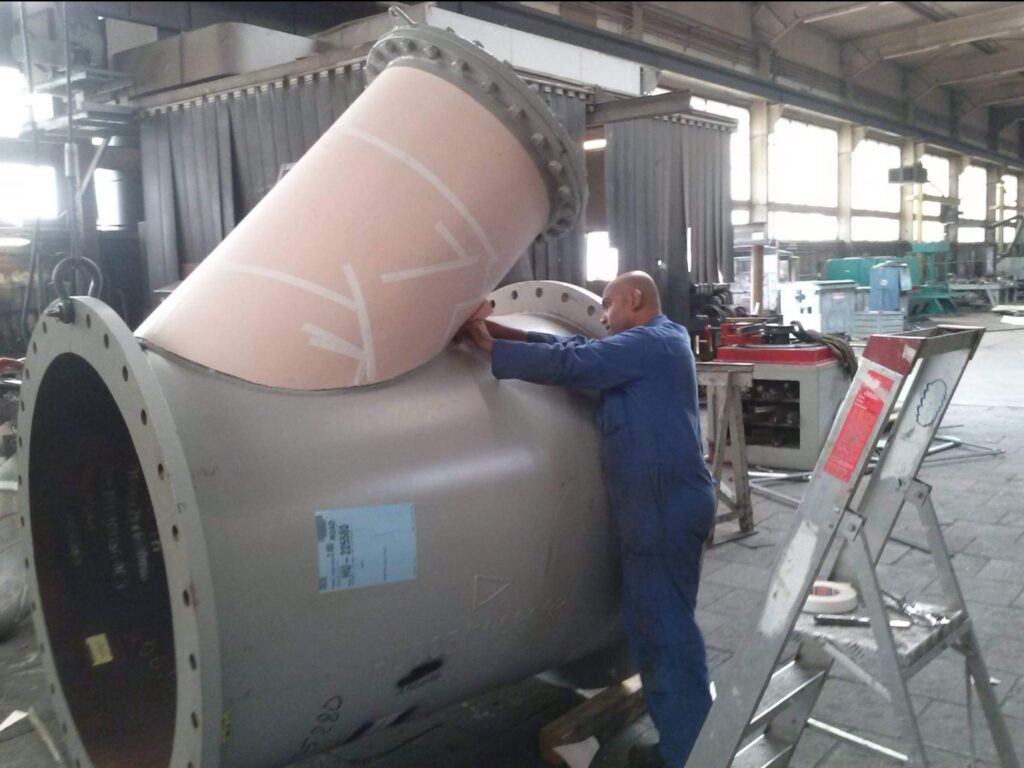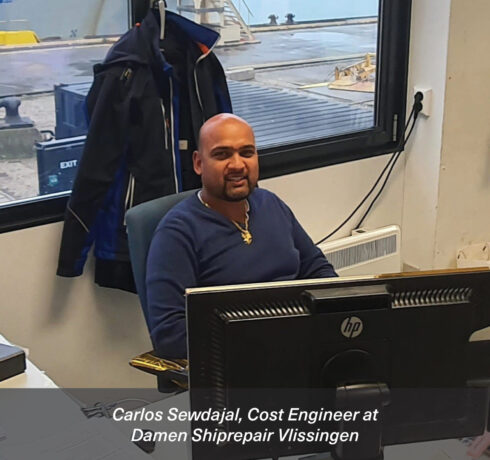From piping to numbers: Carlos Sewdajal initially started as a pipe fitter with De Schelde in 2001, but these days, he is a cost engineer with Damen Shiprepair Vlissingen. Together with three other cost engineers, Carlos draws up invoices and quotes for projects handled by DSV. He likes the work and has no regrets about his remarkable career switch. “It is physically a less demanding job than that of pipe fitter, but mentally it demands more of you. But the work is fun and varied.”
That Carlos would one day earn his living as a cost engineer was something he would never have dared dream when he was still at the LTS. Nevertheless, he was offered the job in 2017, an opportunity he seized with both hands. Carlos already had a good track record as a pipe fitter, a completely different line of work. “At primary school in Breskens, where I come from, I was always good with my hands. I liked to tinker and was a real doer. That is why I went to LTS, where I studied motor vehicle engineering. That course suited me very well.
“In 1999 I started at De Schelde; I was 19 at the time. I was trained up internally to be a pipe fitter. During my training in 2000, I did my first internship at the Shipbuilding department. I helped build the second LCF, HNLMS Tromp, in Hall 2 on Het Eiland. That one was inside at the time, HNLMS De Zeven Provinciën was just finished. My second internship was at Scheldepoort, and I continued working there. Repairing ships was, of course, something completely different from building ships, but I enjoyed it. I remember the Sea Span being rebuilt. That was one of the first projects I worked on at Scheldepoort.”
"I informed management that I would like to do another training course before I was 40. I was 37 then. Two weeks later, they told me that there was a vacancy for cost engineer." Carlos Sewdajal
“Pipefitting is a great job. As a pipe fitter, you dismantle pipes. Then you measure them in the workshop. Using the jig, you then make a new pipe. Jigging is necessary because the flanges of a pipe will eventually become crooked due to the ‘working’ of the ship. And when you put a new pipe back on board, it has to fit, of course… Every time I made something new, and it was fully installed, I was delighted to see that everything fitted. If there was no work to be done, I also helped with welding and on the lathe.”
“You were then temporarily assigned to another department. That made the work fun and varied, but it was physically quite demanding.” In 2006 Carlos became ill. Fortunately, he recovered completely, but after working as a pipe fitter for about sixteen years, in 2017 he wondered whether he wanted to continue doing this until his retirement. “I then informed the management that I would like to do another training course before I was 40. I was 37 then. Two weeks later, they told me that there was a vacancy for Cost Engineer. “They asked: is that something for you?”
 Carlos Sewdajal initially started as a pipe fitter with De Schelde in 2001, but these days, he is a cost engineer with DSV.
Carlos Sewdajal initially started as a pipe fitter with De Schelde in 2001, but these days, he is a cost engineer with DSV.
Much to the displeasure of his pipe fitting supervisor Ad Peters and foreman Peter Boone (after all, they didn’t want to lose such a professional employee), Carlos applied for the job. In October 2017, he was able to start work. “It took some getting used to, of course, but Peter Masius, now retired, gave me excellent guidance at the time. As a cost engineer, I prepare invoices for work done on ships. But, in consultation with the project managers, I also draw up quotations for unforeseen additional work. The budget department draws up a price for a customer. This is done even before the ship is at DSV. Once the ship is here, if it turns out that more work needs to be done than the agreed price, I calculate the cost of the extra work for the customer in a quotation.
“If the customer agrees, the additional work is carried out, and I make out an invoice afterwards. That extra work can sometimes be considerable. Sometimes a ship comes in here for a relatively small job, and then on inspection it turns out that much more needs to be replaced and renewed than expected. The project can then expand considerably.” Carlos’ work is usually linked to a specific project. “Each project that DSV handles has, in addition to its own project manager, its own cost engineer. Since the Covid-19 outbreak, they have been working as much as possible at different locations on the DSV site.”
Carlos is a very social colleague. “I have a chat with everyone,” he says. “When I started as a cost engineer four years ago, that actually came in handy, because I knew all the colleagues, and therefore also knew very well what everyone was working on at that time.” At forty-one, he has no regrets about his change from pipe fitter to cost engineer. “The work is fun and not so physically demanding, although you do have to keep your wits about you. Fortunately, the computer also does a lot of the calculating, which makes a difference… I am happy to work for a company like DSV, which is doing well and has a nice atmosphere. I hope to be doing it for a long time to come.”

